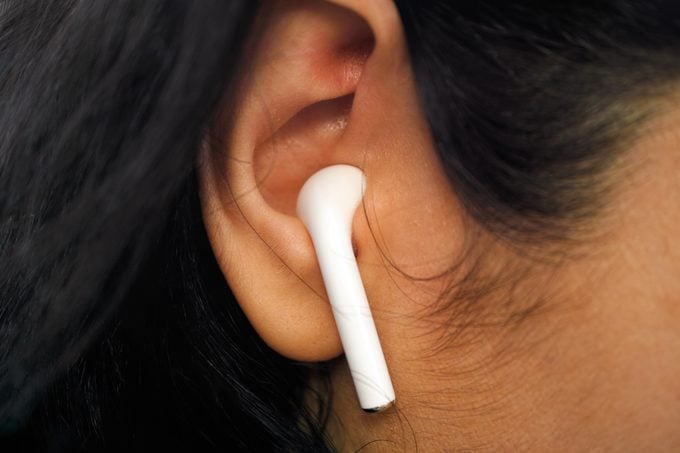Do Wireless Earbuds Harm Your Brain? A Brain Cancer Doctor Sounds Off
Updated: Jul. 06, 2022
How did we live before hands-free? If you're an in-ear headphone devotee, medical experts offer one clever rule so you can help your brain stay healthy for the longterm.
A recent TikTok video made the rounds to thousands of users for its argument entitled, “Why you MUST throw away your AirPods.” In it, the user exclaimed that wireless earbuds “literally sit inside your skull and cook your brain” due to the radiation they emit. Similar alarmist videos have been found across various social media platforms, alleging that wireless earbuds can cause cancer, memory loss, fatigue and other health problems.
A few social platforms have removed these videos, citing they spread medical misinformation. But is there any truth to these claims? Are you compromising your health for the convenience of wireless headphones—and specifically, are you increasing your risk for brain cancer?
Turns out, the answer isn’t entirely clear-cut, but these are prevalent uncertainties right now. “This is a very common worry and a question that I hear often from my patients: They want to know if their phones or earbuds caused their brain cancer,” says Naveed Wagle, MD, a neuro-oncologist at Pacific Brain Tumor Center, Providence Saint John’s Health Center in Santa Monica, California. “The short answer is it’s probably not the sole cause,” Dr. Wagle says, “but we don’t have enough information yet to say for sure or to know if it’s a contributing factor.”
Despite how ubiquitous they’ve become among consumers, this is relatively new technology—when you think about it, widespread cell phone use only dates back about 20 years. And while wireless technology has existed since the late 1990s, wireless earbuds have only come on the scene in the past few years. This short timeframe means that there’s a lot scientists still just don’t know about the long-term health effects, especially for people who use them for hours every day.
For the moment, here’s what the United States Federal Communications Commission (FCC) says about wireless devices and your health:
“Currently no scientific evidence establishes a causal link between wireless device use and cancer or other illnesses. Those evaluating the potential risks of using wireless devices agree that more and longer-term studies should explore whether there is a better basis for [radio frequency] safety standards than is currently used.”
The studies to date warrant a look.
The link between wireless earbuds and cancer
To start, a quick physics lesson: Wireless devices use bluetooth technology. Bluetooth allows these electronics to exchange information over short ranges, like the distance from your phone to your head.
The U.K.’s Institute of Physics explains that bluetooth emits a low amount of radiation in the form of ultrahigh frequency radio waves ranging from 2.402 gigahertz (which equates to 2.4 billion waves per second) to 2.48 gigahertz.
Worth mentioning is that wireless earbuds emit significantly less radiation than phones; in fact, a 2019 study published in Environmental Research found that bluetooth headphones emitted 10 to 400 times less radiation than smartphones. That’s a significant difference between the two.
Does that make either of these devices bad for you? While it might seem natural to hear “radiation” and think Cancer!, cancer is not an inevitable consequence of using these wireless devices. In general, most of us are exposed to low amounts of radiation daily, including from our computers and the sun.
So with all that background understanding, finally: Does the amount of radiation in wireless headphones increase your risk for cancer?
What science says about wireless devices and cancer risk

There is some scientific evidence that there may be a link between exposure to radiofrequency radiation (RFR) in the range used by wireless earbuds and cancer. A 2020 rodent study by the National Toxicology Program found evidence of an association with malignant heart tumors, and some evidence of an association with malignant tumors in the brain and adrenal glands, among rats that had been exposed to RFR.
However, several observational studies of humans have found no increase in cancerous tumors, even among participants with high cell phone use.
(Either way, it probably doesn’t hurt to know these cell phone safety tips.)
Know your personal risk factors
“A lower risk of cancer doesn’t equal no risk, and it can vary from person to person,” Dr. Wagle says.
How much radiation that you personally are exposed to from your wireless devices depends on how long you’re using them, how closely they’re positioned to your head, and the type of device you’re using.
In addition, Dr. Wagle says, you should consider your personal risk profile for different types of cancer, including your family history, weight, diet, exercise, illnesses, and other known risk factors for cancer.
Health problems from wireless earbuds
Aside from cancer, wireless earbuds can cause several health problems, says Bria Collins, Au.D, CCC-A, a licensed audiologist and Associate Director of Audiology Practices for the American Speech-Language-Hearing Association. In fact—because wireless earbud use has grown so popular—Collins says the following health problems have recently been on the rise:
Hearing loss
“When you wear ear buds, it puts the sound source in closer proximity to the eardrum, which can increase the intensity louder than intended,” says Collins. “Over time, this causes hearing loss.”
Tinnitus
Earbud use increases your risk of tinnitus, or a constant ringing in your ears, Collins says.
Wax obstruction
Earwax buildup can be an issue, depending on the type of earbud and the shape and size of your ear canal, she explains. “Inserting the ear tip into the ear over and over, or pushing in the tip too deep into the ear canal, can build up a wall of wax that can occlude the ear and cause reduced hearing,” she explains.
Infection
Constant earbud use also introduces germs into your ear canal where they grow in the warm, moist environment of your inner ear, which can be a catalyst for ear infections, she says. (Hint: This is why you should never ever share your earbuds.)
Pain
If you wear earbuds too much or if they do not fit your ears properly, they can cause some pain and discomfort and occasionally sores in the opening of your ear.
The solution? Don’t keep your earbuds in for hours
If our experts could recommend one thing to everyone who uses wireless earbuds, it is this: Stop keeping your earbuds in your ears when they’re not in use.
“Long term use of earbuds can create a constant loop of noise exposure,” she says. “Plus, I know a lot of people get used to listening through the earbud and if there is other noise or activity in their environment, they may steadily increase the volume.”
Hear this
Both Collins and Dr. Wagle say they themselves occasionally use wireless earbuds and feel confident in their safety, though they keep their use in moderation.
To stay on the safe side, follow the official recommendation Collins refers to as the “60/60 rule”: Limit earbuds use to 60 minutes, at a volume no greater than 60 percent of the maximum volume. Then take a break from wearing for at least 60 minutes before you put them back in.
Sign up for our The Healthy newsletter for real-life wellness wisdom you need. Keep reading:


















